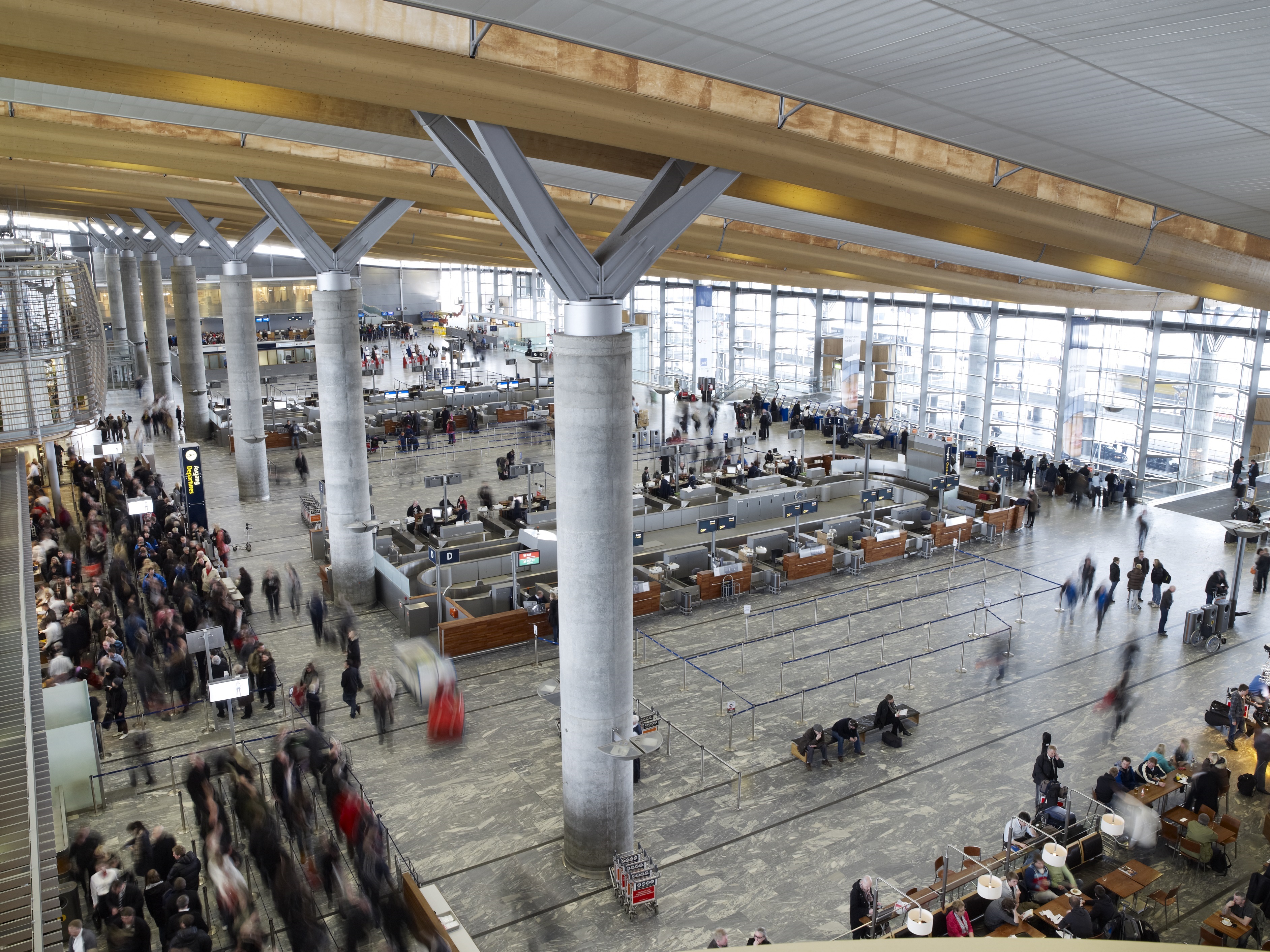Let there be Nordic light. Twenty years ago, architects designed Oslo Airport to be simple and efficient, and to let in lots of light.
The first impression that many foreign visitors have of Norway is of the airport. The designers of Oslo Airport knew how important it was to leave a first impression of beauty, quality and functionality. Today, 20 years after its official opening, Oslo Airport has a new terminal. But right from the start it was acclaimed both for its architecture and for its art collection.
“We wanted to let people see the Nordic light,” says John Røislien, previous Oslo Airport planning manager. He explains that our sunlight is special because the sun both rises and sets very slowly. “Also, we have four very distinct seasons. We wanted people to experience the colors of the seasons.”
Oslo Airport’s immense glass windows let the seasonal sunlight flood the spacious and open terminal and give a view of the skies. A winter landscape draped in white is a contrast to the green of summer or the deep reds and ochres of autumn.
“We wanted to let people see the Nordic light”
Røislien, a civil architect by training, was involved in writing the airport’s Design Manual, working closely with the Oslo Airport main architectural firm Aviaplan AS during the building of the airport during the 1990s. This is the manual that is consulted prior to any new developments, expansion plans or alterations.
Open airport design for Oslo
The designers have had some big and important ideas. “Both the individual buildings and the complex as a whole shall reflect the openness and egalitarian ideals of Norwegian society,” states the Design Manual. “Buildings are to have an open and friendly character.”
There are so many different aspects of airport design, everything from how the runways are located in relation to the terminal, how the logistics are set up, and what vision the architects have of how air travel is going to develop. The designers were intent on building Europe’s most modern airport. Aesthetics may seem like a small part of the total picture, but it is a part that makes some people passionate, including John Røislien.
“The texture of things is so important,” he says, touching a cherry wood countertop at a check-in desk. All of the airport’s countertops are wooden.
“When people come to the airport, they have high levels of stress – even people who travel a lot. That’s a fact, and it can be measured. People’s heart rates increase. I really believe that when they get to the check-in desk, and they can put their hands down on real wood, it calms them down. Natural materials like wood make passengers feel comfortable and relaxed,” says Røislien.
When the Norwegian parliament determined to build a new airport, one of the stipulations was that it must represent “sound Norwegian building traditions.” The architects decided to rely heavily on materials typical of Norway, such as light-coloured wood like pine and spruce, and natural stone floors – none of which are treated with environmentally harmful chemicals and have little need for maintenance. “It’s important that the materials age gracefully,” says Røislien.
OSL Terminal 1 ceiling is airplane wing
One of the features that make the biggest impression on visitors is the ceiling in the terminal, designed to resemble the wing of an airplane. It was one of the most technologically demanding features, as its wooden beams span a distance of 54 meters. This had never been done with wood before.
“When it was in the design phase, we knew that we didn’t have the technology at that time to build it. But we also knew that the technology would come in the following years and we would be able to build it,” says Røislien.
Another challenge involved the immense concrete columns, which showcased technology developed in the Norwegian offshore oil industry in the North Sea.
“We had to improve the technology,” says Røislien, explaining how the columns were built using a vertical slipform, which moves upward as the previously poured concrete hardens behind it. For the airport’s columns, as opposed to offshore installations, it was important that the final result had an exceptionally smooth surface, pleasing to touch.
Oslo Airport growth
Oslo Airport’s design follows the “Atlanta model” – which has the terminal located between two parallel runways. This American-inspired model was used by many airports built in the 1990s, and is optimal for timesaving, with passengers able to get in quickly from their chosen mode of transport to the airport, on to check-in, through security and to the gate with minimal hindrances.
But one underrated aspect at the time was people’s interest in having a wide choice of shops and cafés. In recent years passengers have been spending much more time at the airport than they used to.
Even before the airport was finished the designers realised the need for more commercial space, and a following expansion of the areas designated for shops and restaurants was planned. In 2001, builders completed a major expansion of the pier root that meant more commercial space was available.
In the intervening years, traffic has also increased much faster than estimated. More space is needed. Terminal 2 will open in 2012, but before that time an expansion of the current terminal will help the airport to ‘breathe.’ The east wall is being moved 36 meters out, to give more space. The airport was originally designed with this expansion in mind.
OSL’s inspiration in art
A tour through Oslo Airport today can also be an artistic inspiration. NOK 18 million was granted for the art, making it the largest public art project ever in Norway. Several artists won the contests. Statues, floor art, tapestries, and glass images are spread out through the entire airport. Kai Gjelseth’s bronze floor poetry features famous verses set in the marble floor. The texts are originally in Norwegian, Sami and Old Norse, but translated to 16 different languages, including Chinese and Arabic.
The idea was to give passengers art experiences that they wouldn’t usually find in an airport. Some of the most unusual pieces are 11 ‘sound showers’ that let passengers hear a loop of a soundtrack when they stand directly below the speakers. Whispering voices in some sound showers tell us “you can fly” or “just rest,” while others feature laughing children, running water or breaking waves.
All in all, Oslo Airport has become a place that passengers and employees speak highly of. The Norwegian Directorate for Cultural Heritage (Riksantikvaren) this year has decided to list the building as protected, as it is one of the best examples of excellent Norwegian architecture of the 1990s. The most important architectural elements, such as the floors, the columns and the beams may not be altered.

John Røislien keeps coming back to the importance of the airport’s connection to the natural surroundings. Existing terrain and trees in areas between buildings and adjacent to parking lots have been kept, emphasizing the close relationship Norwegians have to nature. Røislien speaks passionately of the evergreen forest surrounding the airport. In a global perspective, it’s the ‘taiga,’ a sub-arctic evergreen forest that stretches from Norway all the way through Scandinavia, Russia and Siberia to Vladivostok and the Pacific Ocean. It’s important to have that global perspective, to look outward.
Looking at the majestic pine trees that tower between the airport buildings, Røislien says philosophically, “The taiga starts here.”
Oslo Airport architectural awards for Terminal 1
- Houens Fonds Ærespris, the foremost national award for the best building of the 1990s
- The Glulam Award 1996-1999, a European architectural award for large wooden constructions
- Betongprisen (The Concrete Award) for the tower and the concrete columns in the terminal
- Den norske treprisen (The Norwegian Wood Award) for the wooden constructions at the entrances to the parking areas
The Norwegian Directorate for Cultural Heritage (Riksantikvaren) has listed the building as protected, as it is one of the best examples of excellent Norwegian architecture of the 1990s.






















